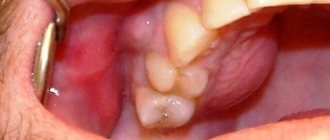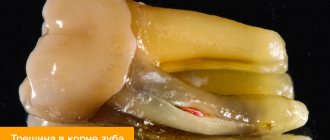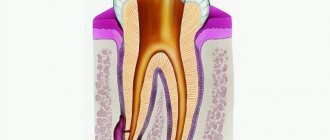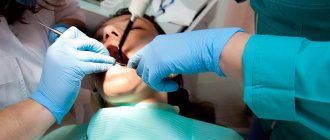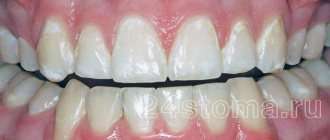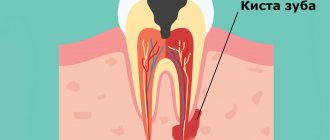Treatment methods for dental cysts
Some experts claim that they can treat a dental cyst without removal - simply by pumping out the purulent fluid from the cavity of the tumor. In some clinics, they can charge up to 30,000 rubles for the procedure, while presenting this manipulation as the “latest technique.”
However, you should not believe empty promises! Six months later, pus and inflammation appear again. Thus, it turns out that the patient is again and again forced to pay a lot of money for a dubious treatment, who receive regular income from this; it is not profitable to cure a person, but it is profitable to treat him endlessly.
Meanwhile, in order to get rid of a dental cyst once and for all, it is necessary, firstly, to properly treat the dental canals, and secondly, to remove all infected tissue, and not just pump out the pus. At the same time, only in the most extreme cases is tooth extraction required! Today, specialists are able to treat a complex multi-channel tooth in just three visits. Only after endodontic treatment, which is necessarily carried out under a microscope, is the patient at the disposal of the surgeon. And this whole set of measures, which will rid you of the problem once and for all, costs significantly less than one-time dubious procedures.
What are dental cysts?
Treatment of dental cyst without removal
It is not possible to carry out tooth-preserving cyst removal in only one situation - if we are talking about a formation that has formed on the surface of a wisdom tooth. Such complex cases are quite rare and are accompanied by severe pain. Here, removal of a cyst on a tooth is carried out in a radical manner. In other cases, tooth-preserving techniques are used - this is an immutable rule. Therefore, before you go to a doctor who suggests pulling out a tooth with a cyst, think a hundred times. Perhaps this is simply profitable and convenient, since implantation can then be offered. Installing an implant is the best method for restoring lost teeth, but throughout the world, tooth-preserving principles are paramount in dental treatment. If a doctor can save a tooth, it is his medical duty to do so.
Stages of formation of a dental cyst
Danger of a cyst on the root of a tooth
The question of why a tooth cyst under a crown is dangerous is asked to dentists very often. The danger of these neoplasms lies in their tendency to actively grow and the ability to provoke a number of complications:
- breakthrough of purulent contents, which can cause blood poisoning;
- phlegmon of the tissues of the face and neck, leading to general infection of the body;
- development of inflammation of the periosteum (flux or periostitis).
Surgery to remove a dental cyst
There are three ways to remove a cyst: cystotomy, hemisection and cystectomy.
Cystotomy
Cystotomy is used for large cysts. The doctor removes only those parts of the formation that do not come into contact with the vessels, after which he installs an obturator - a device that prevents tissue fusion - into the resulting cavity. After some time, the remaining portion of the cyst connects with the epithelium of the oral cavity, changes its structure and ceases to be dangerous to the body.
Hemisection
Removal of a tooth root cyst is carried out through hemisection. During the operation, the formation, one of the roots and the adjacent coronal part are removed. The resulting space is restored with an orthopedic design. However, the above method is quite traumatic, so it is considered outdated.
Cystectomies
The operation to remove a dental cyst is performed using the most modern technique - cystectomy. The method allows you to remove the tumor once and for all without affecting healthy dental tissue. The operation to remove a dental cyst takes place under local anesthesia in a surgical office and involves the use of a microscope. First, the specialist determines where exactly the patient’s tumor is located, “opens” it, cleans out the contents with special tools, leaves an antiseptic inside and stitches it up. After some time, the cavity remaining after the operation heals on its own, which does not require additional replanting of bone blocks. A cystectomy takes from 15 to 40 minutes, depending on the size of the cyst and bone structure. An hour after the operation, the patient can go home.
Why does a cyst appear at the site of an extracted tooth?
The neoplasm is a hollow capsule of dense tissue filled with serous or purulent contents. It occurs as a response of the body to an infection to limit its spread. Thus, the main reason for its appearance is pathogenic microflora.
Provoking factors:
- Tissue infection during nerve extraction or removal. This may be insufficient antiseptic treatment of the surgical field, unsterile instruments, or other doctor’s shortcomings during the procedure.
- The tooth was removed, but the cyst remained. This option is possible if the necessary diagnostics were not carried out and the doctor simply did not notice the pathological formation.
- Dry hole. After extraction, a blood clot is formed, which protects deep tissues from the penetration of bacteria and food debris. If the blood plug comes off or falls out, the opened cavity becomes the center of an accumulation of pathogenic organisms, which become provocateurs of pathology.
- Medical errors during implantation. If the implant is installed soon after removal, infection and capsule formation may also occur during the procedure.
- Failure to follow the doctor’s recommendations during the rehabilitation period. If the patient is negligent about his health, the risk of developing inflammatory processes increases.
Neglecting antibiotic therapy can ultimately cause a purulent infection. A dry socket is formed due to intensive rinsing of the mouth and licking of a blood clot. If the patient smokes or abuses alcoholic beverages, the wound in the mouth does not heal well, which means the risk of complications increases.
Experts' opinion
Question: Is it possible to avoid the occurrence of a cyst on a tooth?
Answer : The etiology of the formation of a cyst at the root of a tooth can be different. At the initial stages, treatment of this pathology does not pose a serious problem. Therefore, it is very important to be regularly examined by a dentist, and also to take x-rays or visiography at least once a year to identify any pathologies of the dental system. New growths, if present, will also be visible on the images. To reduce the likelihood of tumors appearing, if any diseases of the oral cavity and nasopharynx occur, it is necessary to treat them in a timely manner: develop the habit of regularly rinsing your mouth with antiseptics, and learn to brush your teeth correctly. Maintaining a healthy lifestyle, a balanced diet, a strong immune system and preventive dental examinations are the key to dental health.
Question: Is it possible to get rid of a cyst on a tooth at home on your own?
Answer : We do not recommend self-medication if you have any pain or unpleasant symptoms in the oral cavity. Any discomfort may be a sign of a serious illness that requires medical attention. If it is not possible to urgently visit the dentist, then to reduce pain you can use the following rinses: herbal decoctions (yarrow, calendula, sage, chamomile, oak bark), a solution of baking soda or salt, vodka, tea tree essential oil. This may help reduce pain, but in any case you should see a doctor as soon as possible.
How to recognize a cyst on the gum after tooth extraction
The tumor develops slowly and does not manifest itself for a long time. As the size increases, mild symptoms appear, which worsen during periods of acute respiratory infections, stress and other predisposing factors. You can see what a cyst looks like after tooth extraction in the photo.
Symptoms of the development of cystic formation:
- pain, discomfort when pressing on the gums, when biting;
- enlarged lymph nodes;
- swelling of the gums, cheeks;
- increased body temperature;
- development of sinusitis if the neoplasm is located in the maxillary region;
- general malaise, weakness.
If such symptoms appear, you should contact your dentist.
If left untreated
Self-medication or lack of therapy will inevitably lead to the following consequences:
- tooth loss;
- abscess;
- osteomyelitis;
- bone fracture.
Important! It is vital to treat or remove a cyst located under the crown, since it can degenerate into a malignant tumor.
Diagnosis and treatment methods
A radiologist can detect a cyst. In the image, the doctor will see the formation and identify it.
Modern dentistry does not approve of radical tooth extraction when a cyst is detected. Now there are protocols for gentle therapy, and everything does not always end with surgical intervention with dissection of the gum tissue.
Only a qualified doctor can determine which method of treatment (therapeutic or surgical).
The main techniques used by the dentist in treating cysts are:
- Resection of the upper part of the root and hemisection. An incision is made in the gum, the cyst is eliminated, and it is cut out within the living tissue.
- Therapeutic (combined) method. It is used if the tumor has not reached a diameter of more than 8 mm. During treatment, the doctor places injections deep into the gums.
- Cystectomy. Invasive surgery with a long recovery period. After the intervention, a course of antibiotic therapy is required.
- Cystomy. Prescribed for large tumor sizes. Part of the cyst is removed through an incision in the gum, then treated with antimicrobial drugs. Accompanied by long recovery. To simultaneously heal internal and external sutures, the dentist places a special regulator under the gum tissue, which is removed after complete rehabilitation of the patient. Antibiotics are required.
How to treat under an artificial crown
If the cyst is larger than 1 cm, dentists are unanimous: the crown should be removed before starting treatment. Such actions of the doctor are due to possible complications:
- the incision under the crown almost always becomes infected;
- healing under the prosthesis lasts much longer;
- inability to properly treat the surgical area before and after the intervention.
If a pin is installed under the crown, it should also be removed, after first getting rid of the upper part of the prosthesis.
General overview
In dentistry, a cyst refers to benign neoplasms localized in the structure of mucous tissues located near the roots of the teeth. The capsule, formed from fibrous tissue, is filled with a liquid composition containing epithelial cells that have undergone necrotic changes, as well as dead bacteria. During development, the contents of the cyst are converted into a purulent mass.
For most cases, the main prerequisite for pathology is infectious infection. The body, seeking to counteract the disease, sends immune cells to the localized area, whose task is to contain the spread. At the same time, complete independent elimination of pathogenic microflora, without proper medical intervention, is almost impossible. Cystic formations are the result of severe damage and lead to a deterioration in the general condition of the patient.
What is a cyst
This is a benign neoplasm that usually occurs in the bone tissue of the jaw and is localized at the apex of the tooth root. In the later stages, it can be seen through manifestations of the mucous membrane (a lump appears on the gum). In appearance, the neoplasm has a rounded outline and looks like a small ball. The outside is lined with dense fibrous tissue, the inside is serous or purulent contents, as well as dead cells produced by the body’s immune system and aimed at fighting the source of the initial infection. Most often, when you go to the doctor, pus is still found inside the fibrous sac, because the initial stage of the disease does not cause the patient any concern and may not manifest itself in any way, but the inflammatory process continues to develop.
Important! Modern technologies make it possible to carry out gentle tooth-preserving operations and completely remove the cyst under a microscope. Optical technology provides doctors with many advantages: it makes the treatment process completely visualized, controlled and predictable. The microscope creates additional illumination and increases the working area by 30-40 times, due to which all affected tissues are excised without residue, healthy ones are preserved, and the canals are hermetically sealed.
Signs of a cyst under the crown, as a rule, are even more difficult to detect than if the tooth had not been treated and filled - the patient in such a situation simply does not even suspect that something is wrong, since the crown is in place. Therefore, the doctor diagnoses the disease either during a routine examination, or on an x-ray, or even after the patient presents with relevant complaints.
How to protect yourself from pathology
To eliminate the possibility of dangerous consequences of prosthetics, incl. the appearance of a cyst under the crown, you need to very carefully choose an orthopedic dentist and a dental therapist. The first one selects the prosthesis, prepares the tooth for its installation and, in fact, ensures the fixation of the crown or bridge. But before that, you need to visit a dentist-therapist who will treat the root canals and carefully seal them. An indicator of the responsibility of doctors is the number of x-rays during the treatment process - at least 5 of them are taken in the process of preparation and prosthetics. They show the smallest voids in the canals and the loose fit of the parts of the prosthesis - if the doctor is not satisfied with the result, he will bring the work to perfection. And the patient will wear dentures without pain and negative consequences.



